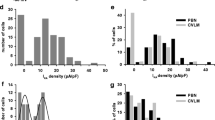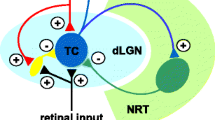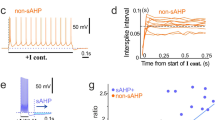Abstract
Transient A-type K+ currents (IA) are known to influence the firing pattern of a number of thalamic cell types, but have not been investigated in intralaminar thalamocortical (TC) relay neurons yet. We therefore combined whole-cell patch-clamp techniques, PCR analysis, and immunohistochemistry to investigate the voltage-dependent and pharmacological properties of IA and to determine its molecular basis in TC neurons from the centrolateral, paracentral, and centromedial thalamic nuclei. IA revealed half-maximal (V h) activation and inactivation at about −17 and −67 mV, respectively. At a concentration of 5–10 mM 4-aminopyridine (4-AP) completely blocked IA. Furthermore, IA was nearly unaffected by two sea anemone toxins (blood depressing substances 1 and 2, BDS1 and BDS2; 6–8% block at a concentration of 1 μM) but strongly sensitive to the KV4 channel blocker Heteropoda venatoria toxin 2 (HpTx2; about 45% block at a concentration of 5 μM). PCR screening revealed the expression of KV4.1–4.3, with strongest expression for KV4.2 and weak expression for KV4.1. Accordingly KV4.1 was not detected in immunohistochemical staining. Furthermore, KV4.2 and KV4.3 revealed mainly dendritic and somatic staining, respectively. Together with current clamp recordings, these findings point to a scenario where the fast transient IA in intralaminar TC neurons has a depolarized threshold at potentials negative to −50 mV, is substantially generated by KV4.2 and KV4.3 channels, allows prominent burst firing at hyperpolarized potentials, prevents the generation of high-threshold potentials, generates a delayed onset of firing at more depolarized potentials, and allows fast tonic firing.







Similar content being viewed by others
References
Aronica E, Boer K, Doorn KJ, Zurolo E, Spliet WG, van Rijen PC, Baayen JC, Gorter JA, Jeromin A (2009) Expression and localization of voltage dependent potassium channel Kv4.2 in epilepsy associated focal lesions. Neurobiol Dis 36:81–95
Bekar LK, Loewen ME, Cao K, Sun X, Leis J, Wang R, Forsyth GW, Walz W (2005) Complex expression and localization of inactivating Kv channels in cultured hippocampal astrocytes. J Neurophysiol 93:1699–1709
Benarroch EE (2008) The midline and intralaminar thalamic nuclei: anatomic and functional specificity and implications in neurologic disease. Neurology 71:944–949
Broicher T, Kanyshkova T, Landgraf P, Rankovic V, Meuth P, Meuth SG, Pape HC, Budde T (2007) Specific expression of low-voltage-activated calcium channel isoforms and splice variants in thalamic local circuit interneurons. Mol Cell Neurosci 36:132–145
Broicher T, Kanyshkova T, Meuth P, Pape HC, Budde T (2008) Correlation of T-channel coding gene expression, I(T), and the low threshold Ca(2+) spike in the thalamus of a rat model of absence epilepsy. Mol Cell Neurosci 39:384–399
Budde T, Coulon P, Pawlowski M, Meuth P, Kanyshkova T, Japes A, Meuth SG, Pape H-C (2008) Reciprocal modulation of Ih and ITASK in thalamocortical relay neurons by halothane. Pflügers Arch 456:1061–1073
Budde T, Mager R, Pape H-C (1992) Different types of potassium outward current in relay neurons acutely isolated from the rat lateral geniculate nucleus. Eur J Neurosci 4:708–722
Budde T, Pape H-C, Kumar SS, Huguenard JR (2006) Thalamic, thalamo-cortical, and cortico-cortical models of epilepsy with an emphasis on absence seizures. In: Pitkänen A, Schwartzkroin PA, Moshé SL (eds) Models of seizures and epilepsy. Elsevier, Amsterdam, pp 73–88
Connor JA, Stevens CF (1971) Voltage clamp studies of a transient outward current in gastropod neural somata. J Physiol Lond 213:21–30
Covarrubias M, Bhattacharji A, De Santiago-Castillo JA, Dougherty K, Kaulin YA, Na-Phuket TR, Wang G (2008) The neuronal Kv4 channel complex. Neurochem Res 33:1558–1567
Dabrowska J, Rainnie DG (2010) Expression and distribution of Kv4 potassium channel subunits and potassium channel interacting proteins in subpopulations of interneurons in the basolateral amygdala. Neurosci 171:721–733
Decher N, Streit AK, Rapedius M, Netter MF, Marzian S, Ehling P, Schlichthorl G, Craan T, Renigunta V, Kohler A, Dodel RC, Navarro-Polanco RA, Preisig-Muller R, Klebe G, Budde T, Baukrowitz T, Daut J (2010) RNA editing modulates the binding of drugs and highly unsaturated fatty acids to the open pore of Kv potassium channels. EMBO J 29:2101–2113
DeSimone CV, Lu Y, Bondarenko VE, Morales MJ (2009) S3b amino acid substitutions and ancillary subunits alter the affinity of Heteropoda venatoria toxin 2 for Kv4.3. Mol Pharmacol 76:125–133
Diochot S, Schweitz H, Beress L, Lazdunski M (1998) Sea anemone peptides with a specific blocking activity against the fast inactivating potassium channel Kv3.4. J Biol Chem 273:6744–6749
Dixon WJ, Massey FJ (1969) Introduction to statistical analysis. McGraw Hill, New York
Hille B (2001) Ion channels of excitable membranes. Sinauer Associates, Sunderland
Huguenard JR (1996) Low-threshold calcium currents in central nervous system neurons. Annu Rev Physiol 58:329–3248
Huguenard JR, Coulter DA, Prince DA (1991) A fast transient potassium current in thalamic relay neurons: kinetics of activation and inactivation. J Neurophysiol 66:1304–1315
Huguenard JR, Prince DA (1991) Slow inactivation of a TEA-sensitive K current in acutely isolated rat thalamic relay neurons. J Neurophysiol 66:1316–1328
Jerng HH, Pfaffinger PJ, Covarrubias M (2004) Molecular physiology and modulation of somatodendritic A-type potassium channels. Mol Cell Neurosci 27:343–369
Jerng HH, Qian Y, Pfaffinger PJ (2004) Modulation of Kv4.2 channel expression and gating by dipeptidyl peptidase 10 (DPP10). Biophys J 87:2380–2396
Jo A, Nam YJ, Oh JY, Cheon HS, Jeromin A, Lee JA, Kim HK (2010) Dendritic localization and a cis-acting dendritic targeting element of Kv4.2 mRNA. BMB Rep 43:677–682
Judge SI, Monteiro MJ, Yeh JZ, Bever CT (1999) Inactivation gating and 4-AP sensitivity in human brain Kv1.4 potassium channel. Brain Res 831:43–54
Kaulin YA, De Santiago-Castillo JA, Rocha CA, Nadal MS, Rudy B, Covarrubias M (2009) The dipeptidyl-peptidase-like protein DPP6 determines the unitary conductance of neuronal Kv4.2 channels. J Neurosci 29:3242–3251
Kim J, Nadal MS, Clemens AM, Baron M, Jung SC, Misumi Y, Rudy B, Hoffman DA (2008) Kv4 accessory protein DPPX (DPP6) is a critical regulator of membrane excitability in hippocampal CA1 pyramidal neurons. J Neurophysiol 100:1835–1847
Li HL, Qu YJ, Lu YC, Bondarenko VE, Wang S, Skerrett IM, Morales MJ (2006) DPP10 is an inactivation modulatory protein of Kv4.3 and Kv1.4. Am J Physiol Cell Physiol 291:C966–C976
Lo FS, Ziburkus J, Guido W (2002) Synaptic mechanisms regulating the activation of a Ca2+-mediated plateau potential in developing relay cells of the LGN. J Neurophysiol 87:1175–1185
Maffie J, Rudy B (2008) Weighing the evidence for a ternary protein complex mediating A-type K+ currents in neurons. J Physiol 586:5609–5623
McCormick DA (1991) Functional properties of a slowly inactivating potassium current in guinea pig dorsal lateral geniculate relay neurons. J Neurophysiol 66:1176–1189
Meis S, Biella G, Pape H-C (1996) Interaction between low voltage-activated currents in reticular thalamic neurons in a rat model of absence epilepsy. Eur J Neurosci 8:2090–2097
Min MY, Wu YW, Shih PY, Lu HW, Wu Y, Hsu CL, Li MJ, Yang HW (2010) Roles of A-type potassium currents in tuning spike frequency and integrating synaptic transmission in noradrenergic neurons of the A7 catecholamine cell group in rats. Neurosci 168:633–645
Oliver D, Lien CC, Soom M, Baukrowitz T, Jonas P, Fakler B (2004) Functional conversion between A-type and delayed rectifier K+ channels by membrane lipids. Science 304:265–270
Pape H-C, Budde T, Mager R, Kisvarday Z (1994) Prevention of Ca2+-mediated action potentials in GABAergic local circuit neurons of the thalamus by a transient K+ current. J Physiol Lond 478(3):403–422
Perez-Reyes E (2003) Molecular physiology of low-voltage-activated t-type calcium channels. Physiol Rev 83:117–161
Radicke S, Vaquero M, Caballero R, Gomez R, Nunez L, Tamargo J, Ravens U, Wettwer E, Delpon E (2008) Effects of MiRP1 and DPP6 beta-subunits on the blockade induced by flecainide of Kv4.3/KChIP2 channels. Br J Pharmacol 154:774–786
Rettig J, Heinemann SH, Wunder F, Lorra C, Parcej DN, Dolly JO, Pongs O (1994) Inactivation properties of voltage-gated K+ channels altered by presence of beta-subunit. Nature 369:289–294
Rhodes KJ, Carroll KI, Sung MA, Doliveira LC, Monaghan MM, Burke SL, Strassle BW, Buchwalder L, Menegola M, Cao J, An WF, Trimmer JS (2004) KChIPs and Kv4 alpha subunits as integral components of A-type potassium channels in mammalian brain. J Neurosci 24:7903–7915
Robertson B (1997) The real life of voltage-gated K+ channels: more than model behaviour. Trends Pharmacol Sci 18:474–483
Rudy B (1988) Diversity and ubiquity of K+ channels. Neurosci 25:729–749
Rudy B, Chow A, Lau D, Amarillo Y, Ozaita A, Saganich M, Moreno H, Nadal MS, Hernandez-Pineda R, Hernandez-Cruz A, Erisir A, Leonard C, Vega-Saenz de Miera E (1999) Contributions of Kv3 channels to neuronal excitability. Ann NY Acad Sci 868:304–343
Sanguinetti MC, Johnson JH, Hammerland LG, Kelbaugh PR, Volkmann RA, Saccomano NA, Mueller AL (1997) Heteropodatoxins: peptides isolated from spider venom that block Kv4.2 potassium channels. Mol Pharmacol 51:491–498
Serodio P, Rudy B (1998) Differential expression of Kv4 K+ channel subunits mediating subthreshold transient K+ (A-type) currents in rat brain. J Neurophysiol 79:1081–1091
Sherman SM, Guillery RW (2006) Exploring the thalamus and its role in cortical function. MIT, Cambridge
Song WJ (2002) Genes responsible for native depolarization-activated K+ currents in neurons. Neurosci Res 42:7–14
Steriade M, Curro Dossi DR, Contreras D (1993) Electrophysiological properties of intralaminar thalamocortical cells discharging rhythmic (approximately 40 Hz) spike-bursts at approximately 1,000 Hz during waking and rapid eye movement sleep. Neurosci 56:1–9
Steriade M, Glenn LL (1982) Neocortical and caudate projections of intralaminar thalamic neurons and their synaptic excitation from midbrain reticular core. J Neurophysiol 48:352–371
Steriade M, Jones EG, McCormick DA (1997) Thalamus. Elsevier, Amsterdam
Tennigkeit F, Schwarz DW, Puil E (1998) Modulation of bursts and high-threshold calcium spikes in neurons of rat auditory thalamus. Neurosci 83:1063–1073
Van der Werf YD, Witter MP, Groenewegen HJ (2002) The intralaminar and midline nuclei of the thalamus. Anatomical and functional evidence for participation in processes of arousal and awareness. Brain Res Brain Res Rev 39:107–140
Xiong H, Kovacs I, Zhang Z (2004) Differential distribution of KChIPs mRNAs in adult mouse brain. Brain Res Mol Brain Res 128:103–111
Yeung SY, Thompson D, Wang Z, Fedida D, Robertson B (2005) Modulation of Kv3 subfamily potassium currents by the sea anemone toxin BDS: significance for CNS and biophysical studies. J Neurosci 25:8735–8745
Acknowledgments
The authors thank E. Nass for the excellent technical assistance. This work was supported by DFG (BU 1019/8-1 to TB; PA 336/17-1 to HCP) and the fund “Innovative Medical Research” of the University of Münster Medical School (BU 12 08 03 to TB).
Author information
Authors and Affiliations
Corresponding author
Rights and permissions
About this article
Cite this article
Kanyshkova, T., Broicher, T., Meuth, S.G. et al. A-type K+ currents in intralaminar thalamocortical relay neurons. Pflugers Arch - Eur J Physiol 461, 545–556 (2011). https://doi.org/10.1007/s00424-011-0953-2
Received:
Accepted:
Published:
Issue Date:
DOI: https://doi.org/10.1007/s00424-011-0953-2




